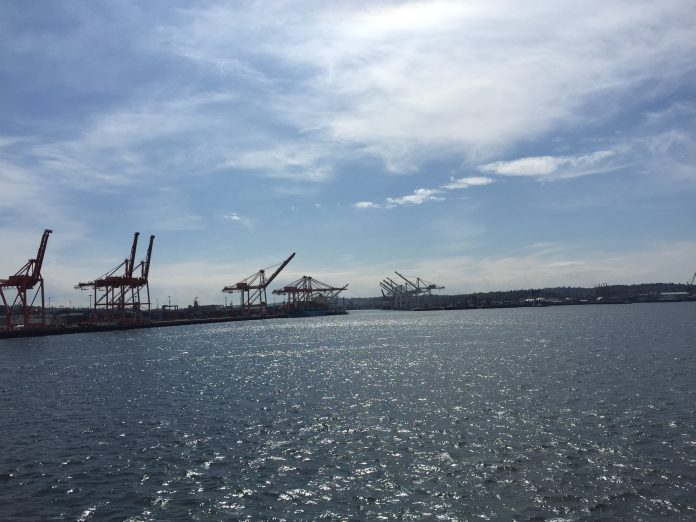The Port of Seattle, and its sister port in Tacoma, as part of the Northwest Seaport Alliance is a large-scale operation supporting about a third of Washington gross domestic product, employing tens of thousands of Washingtonians, and moving 3.7 million containers per year. The current 10-year strategic plan calls for growing the port to 6.0 million containers by 2025. The Port of Seattle is investing up to a billion dollars over the next decade ($) to improve the access of new huge cargo ships by deepening Terminal 5 in addition to docks, cranes, and transportation. These new huge cargo ships are 400 meters (about a quarter-mile) long, require a deep port for their 16-meter (52.5 feet) draft, and carry 18,000 containers.
Is there a way to harness these changes to our ports to allow for more growth while also building resilience to climate change, improving the cities that grew up around them, and allowing for environmental restoration?
Today, the ports are built on waterways and islands dredged from the Duwamish tidal flats in 1909. Continuing to invest in this old configuration and infrastructure has limited upside, and instead the Port of Seattle, the City of Seattle, and Washington State should consider investing growth into a new floating port. The technology to allow for a floating port is under investigation around the world in places like Japan, Korea, Scotland, and the Netherlands. Generally created from hollow cement pontoons, similar to the new SR-520 bridge, floating ports allow for new space in deeper water. In Seattle, a floating port would allow operations to be removed from the delicate environments of the Duwamish tidal flats into the deeper water of Elliott Bay.
Beyond economics, the benefits of a floating port for the City of Seattle also come from the potential for environmental restoration and the redevelopment of hundreds of acres of coastal lands no longer needed as port terminals. Harbor Island and both the West Seattle and SoDo waterfronts present a challenging but rewarding opportunity for environmental restoration. The pollution would need to be removed from all the sites, but then both the West Seattle waterfront, and Harbor Island could be returned to more natural tide flats–providing an amenity for Seattleites, habitat for native species, and a buffer against predicted sea level rise. The SoDo waterfront could become an improved sea wall with a wide stretch of green flood protection in a model similar to what many cities are doing with their urban rivers and connecting with Seattle’s new downtown waterfront.
Even with extensive environmental restoration, there should still be over a hundred acres of land left over to redevelop. This land can become places that allow thousands of people to live and work near these new amenities, growing number of port jobs, and downtown Seattle without cutting into the industrial heart of the city in SoDo. Rotterdam is a good example of a large successful port, where excese port land is being redeveloped for residents.
The final benefit of moving the Port of Seattle operations to a floating port is that it can be done incrementally with minimal interruption of port activities. There is about 1,000 acres of deep water between the current port operations and the downtown ferry routes. It should be possible for floating sections to be added as there is time and money to develop them until they create a floating terminal.
Cost was roughly estimated using costs from the recently built SR-520 floating bridge. The completed bridge, with all the bells and whistles, created approximately 35 floating acres for $4.51 billion, resulting in about $130 million per acre. However, judging by just the cost of the pontoons, a floating deck can be created for closer to $18.5 million per acre. From these numbers and current port layout, the estimate of an individual floating terminal, with space for containers, would be about 75 acres (costing roughly between $1.4 billion and $9.8 billion).
These individual floating terminals can then become part of port operations by unloading larger vessels onto barges that can ferry the cargo to the remaining port facilities on land. Ultimately, there is the potential to grow the new floating port into nearly 500 acres that could handle 15 or more of the futures ultra-big ships, or other operations. In this way Seattle can reclaim part of its long abused river tidal flats, create new amenities and neighborhoods for its people, while creating a port that can grow sustainably into the future.
Greg is a climate scientist and aerospace engineer with a PhD and bachelors from the University of Washington. He advocates for a city full of housing, commerce, industry, and recreation as ways to increase resilience to climate change, and reduce carbon emissions.

Gregory Quetin
Gregory Quetin is a climate scientist and aerospace engineer with a PhD and bachelor's degree from the University of Washington. He advocates for a city full of housing, commerce, industry, and recreation as ways to increase resilience to climate change and reduce carbon emissions.

